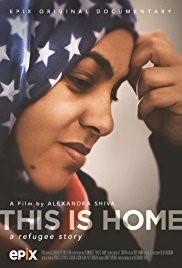
Courtesy Sundance Institute
The documentary This is Home: A Refugee Story follows four Syrian families as they maneuver through the hurdles of creating their new lives in the US. The film begins with the families initial meeting with the International Rescue Committee (IRC), which offers eight months of assistance in language, housing, and job assistance. After the eight months is up, clients of the IRC can no longer receive any assistance from the organization.
This is Home is structured around those eight months, chronicling the struggles and the accomplishments along the way. The tension of the film is balanced with several moments of humor and tenderness. It is impossible not to root for these families, not to share in their frustrations, and not to feel the insurmountable crunch of the impending discontinuance of the IRC assistance.
Although the families share in many of the same struggles, each family also has their own set of unique obstacles to overcome. There is Khaldoun and Yasmen, who have four children. Khalodoun rejects the notion of Yasmen having to work when employees of the IRC explain it will likely be necessary in order for the family to be self-sufficient. Mahmoud and Madiha also have four children, including a teenage son who plays a predominant role in exposing the emotional toll their experience in Syria can take on a child. The third family is Mohammad and his wife, whose identity is withheld for the safety of her family back home, and their four children. The fourth family has a very different dynamic than the others. Iman came to the US seeking asylum a few years prior to her three grown daughters’ arrival. In addition to pursuing their educational goals, the daughters have to become re-accustomed to being under the same roof as their mother.
The screening was followed by a Q&A with the film’s director/producer Alexandra Shiva, producer Lindsey Megrue, editor Toby Shimin, and assistant editor Joy Reed. During the Q&A, various aspects about the how the documentary was made and insights into some of the stylistic decisions were discussed. Shiva acknowledged her light verite approach, and stated her aim was to figure out “how do we get into the lives of the people we’re filming and not just stare at them. It was about bridge building.” She also noted that structurally it would have been easier to go with three families instead of four, but she thought it was more important to go with the four families given their differences. For her part, editor Toby Shimin, shared that her choice of what footage to use was different than if the footage had been in English. She was focused on finding “universal, non-verbal scenes”. One of her main objectives was to balance the humor and the heartbreak.
What came through most during the Q&A was the affection that the filmmakers have for the families. When the film premiered at Sundance, Reed mentioned how star-struck she was by seeing the members of the family in person (three of the four families attended the Sundance premiere). Shiva told a story of sitting at a table well into filming, and Iman literally trying to feed her as they sat during the family having a meal. Megrue told a story about one of the children running up to her and hugging her after she came back to film after a long break, and how she didn’t realize that the children had formed an affinity for her through the filming. To their credit, the film is infused with the warmth they feel towards the families.
Although compelling, This is Home is a fairly conventional documentary. The most remarkable thing about it may be how the film came to be. In the Q&A after the film screening, Shiva mentioned that the documentary was made after the Princess Firyal of Jordan reached out to Shiva about making the film after having seen Shiva’s earlier work, How to Dance in Ohio. This is Home isn’t just executive produced by a princess, it is also executive produced by Jason Blum, horror film champion (founder and CEO of Blumhouse Productions), whose production company is behind such titles as Paranormal Activity and Get Out. In speaking about Blum’s involvement, Shiva told the audience that Blum is interested in films that are “not just about monsters, but what keeps you up at night.”
Shiva was intent on producing a film that “humanizes and connects individuals in non-political ways.” Ultimately, she succeeded in that effort. This is Home is compelling and heartwarming, and above all it is a human story, not a political one, of home and family.
